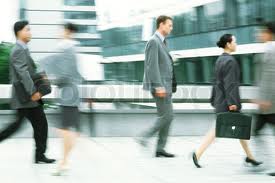I'll bet you are reading this while sitting at your desk and probably multi-tasking at the same time.
If you are, your assignment today is to go for a stroll before solving any of today's problems. Why? 
Because a long suspected, but now proven, link between walking and increased creativity has been made. The below excerpt is from the NY Times Well Blog.
“Researchers at Stanford University recently decided to test that possibility, inspired, in part, by their own strolls. “My adviser and I would go for walks” to discuss thesis topics, said Marily Oppezzo, at the time a graduate student at Stanford. “And one day I thought: ‘Well, what about this? What about walking and whether it really has an effect on creativity?’”
As a result of the above discussion they structured the following research project:
They placed “volunteers" in a deliberately dull, unadorned room equipped with only a desk and (somewhat unusually) a treadmill. Dr. Oppezzo asked the students to sit and complete tests of creativity, which in psychological circles might involve tasks like rapidly coming up with alternative uses for common objects, such as a button. Then the participants walked on the treadmill, at an easy, self-selected pace that felt comfortable. The treadmill faced a blank wall. While walking, each student repeated the creativity tests, which required about eight minutes.
For almost every student, creativity increased substantially when they walked. Most were able to generate about 60 percent more uses for an object, and the ideas were both “novel and appropriate,” Dr. Oppezzo writes in her study, which was published this month in The Journal of Experimental Psychology: Learning, Memory, and Cognition.
But how practical is it to take an entire team or business unit out for a stroll?
So Dr. Oppezzo next tested whether the effects lingered after a walk had ended. She had another group of students sit for two consecutive sessions of test-taking and subsequently walk for about eight minutes while tossing out ideas for object re-use, then sit and repeat the test.
Again, walking markedly improved people’s ability to generate creative ideas, even when they sat down after the walk. In that case, the volunteers who had walked produced significantly more and subjectively better ideas than in their pre-exercise testing period.
Finally, to examine another real-world implication of walking and creativity, Dr. Oppezzo moved portions of the experiment outdoors. “Most people would probably guess that walking outside should be much better for creativity” than pacing inside a drab office. But surprisingly, her study undermined that assumption. When volunteers strolled Stanford’s pleasant, leafy campus for about eight minutes, they generated more creative ideas than when they sat either inside or outside for the same length of time. But they were not noticeably more creative as a result of their plein-air walk than when they subsequently walked on an indoor treadmill, facing a blank wall.
“It really seems that it’s the walking that matters,” in terms of spurring creativity, Dr. Oppezzo said, and not the setting.
Just how a brief, casual stroll alters the various mental processes related to creativity remains unclear, Dr. Oppezzo added. “This is an acute effect,” she said, making it distinct from any long-term physiological changes that exercise might produce inside the human brain. “It may be that walking improves mood” as its primary effect, she said, and creativity blooms more easily within a buoyed-up mind.
Or walking may divert energy that otherwise would be devoted, intentionally or not, to damping down wild, creative thought, she said. “I think it’s possible that walking may allow the brain to break through” some of its own, hyper-rational filters, she said.
But those are only a few of many likely explanations, she said, adding that she would probably go for a walk later to help her come up with other plausible theories and inventive experiments through which to test them.
If you’re like me, I have a habit of sitting in my chair, staring off into space and thinking and…thinking some more. I always believed that this was a technique for stimulating a breakthrough of thought and creativity.
It appears based on the preceding research that I am really just wasting valuable time and this method is less than ideal.
A brief amble is what I need. The great news is I now have "permission" and a valid objective to get up from the chair, and go for a stroll.
I hope you do too.
 Editor's Note: This article was written by Dr. David Mashburn. Dave is a Clinical and Consulting Psychologist, a Partner at Tidemark, Inc. and a regular contributor to WorkPuzzle.
Editor's Note: This article was written by Dr. David Mashburn. Dave is a Clinical and Consulting Psychologist, a Partner at Tidemark, Inc. and a regular contributor to WorkPuzzle.

